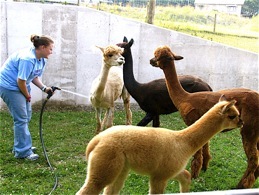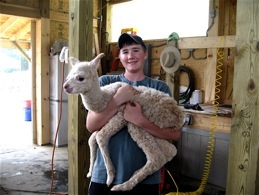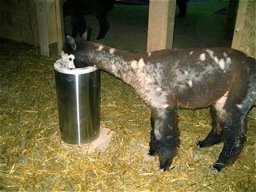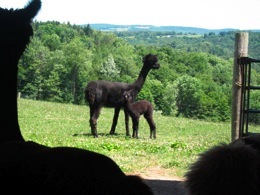Do Alpacas Fly?
Alpacas, Vicugna pacos, are browsers who walk on four legs, are small, quiet and relatively easy animals to raise. They stand about 36 inches tall at the withers, weigh 100-200 pounds, and live 15—25 years. There are two alpaca breeds: the huacaya and the suri. The alpacas pictured here are huacayas. And, no, they do not, never have, and never will...fly.
We must provide them with plenty of fresh water to drink, shelter for protection from heat and foul weather, predator-secure fencing, and, being livestock, they require certain vaccinations and anti-parasitic medicines. Additionally, toenails need to be trimmed periodically, and fleeces are sheared each spring. Alpacas share communal dung piles that are easy to manage. These animals do not have hooves—each foot has two toes, and a soft pad, much like a dog’s paw—so there is no compaction of the soil to the same degree that would occur with other types of livestock.
Alpacas eat grass or hay—approximately two pounds per 125 pounds of body weight per day. A single, 40-pound bale of hay can generally feed a group of about 20 alpacas for one day. We also feed them small amounts of grain, in the moring and evening. Additionally, all alpacas require access to electrolytes and free-choice mineral supplements.
Alpacas produce one cria (baby) a year, and rarely have twins. Alpacas are “induced ovulators” so conception can occur at any time of the year. We plan for spring births to give the cria time to grow and put on weight before the rigors of our mountaintop winters. The adorable cria are curious, fun-loving creatures who chase and run through the pastures, springing all four feet off the ground in a joyous movement called “pronking.”
To watch and work with these animals is to understand why we raise alpacas. Their beauty, strength, intelligence and curiosity create a sublime environment: a sure release from the pressures of our hectic world.
-
1.Above, Starry runs to join his herd mates in a race around the pasture. Alpacas run faster than pumas who are their main predator in the Andes mountains.
-
2.Our vegetable garden is adjacent to one of our girls’ pastures. They love to eat beet and carrot tops.
-
3.Jacob Saxe spent hours every week during the summer helping out with the everyday aspects of alpaca care, including giving the girls their favorite treat: orchard grass from Wyoming.
-
4.During hot weather, we spray the bellies and legs of our alpacas to keep them cool (waters the grass, too). Abby Bressler, a visitor to the farm, is doing a great job.
-
5.Happiness is a fluffy cria. Matthew Fountain is demonstrating the correct way to hold a newborn.
-
6.Newborn cria, Aurora, with her dam, Samba.

No, Alpacas can’t fly, but they sure can run like the wind!






2
3
4
5

6
